A device that does it all….
Did you ever wonder…. “I wish….” followed by a slur of demands and closing with “and it shouldn’t break the bank”?
I know I do, and in all honesty it never really happens.
I love teaching and interacting with people, but ever since the outbreak of Covid-19 this all changed a lot, and unless you already live in isolation I think for 99% of the world population things have changed and will be different for the coming years.
So what do you do?
Well we go online of course… the amount of live streams have increased immensely, but also video calling to your friends and family, clients, meetings etc. a lot is now online, and in all honesty let’s hope it stays that way for the coming years, now do place that in the right perspective, of course I mean, why travel an hour for a small meeting and travel back when it can also be done online, right?
So online will be more important than ever, and this is EXACTLY where this review is all about.
Even when you don’t do any streaming, keep reading to the end
Digital Classroom
I’ve always had this “dream” of being able to teach from our studio to everyone that wants to see it but is not able to visit one of my workshops or seminars. Now streaming something like a Digital Classroom is very expensive. Let’s go through what we use.
First of course 4 cameras.
Than a hardware mixer where all cameras are fed into + monitor to see the feeds.
A mixer for audio.
A Blackmagic convertor to the PC.
A special Magewell convertor for my desktop because it’s a different resolution from the cameras.
Wirecast as software hub (you can also use the free OBS, but Wirecast is in my opinion a lot easier and more flexible)
In total …. you don’t want to know 🙂
Luckily with Digital Classroom we are supported by our friends from BenQ and Rogue/Expo Imaging, otherwise we really would not be able to afford this.
Problems and solutions
The biggest problem we encountered was hooking everything up to make it work.
In our system all cameras have to be set to the exact same resolution otherwise the mixer won’t recognize the stream. The desktop has to be fed via another convertor because I want to be able to use Picture in Picture and this is not possible with the hardware switcher.
Now when we go live, our intern or Annewiek only has to look at the camerascreen and select the view they want to show live and switch between those cameras on the switcher. If they want picture in picture, they have to select this in Wirecast and switch. It’s a system that works VERY well, and is super easy, but it’s FAR from portable and as mentioned it’s expensive.
RGBLink
A while ago I saw a video of small video switcher that does it all…. yeah I’ve heard that before.
And that’s actually 100% true, we tried different solutions and most of them did work maybe for a gamer that streams some video to his/her friends or on Twitch, but it was a far cry from what we needed, so in all honesty I didn’t expect much, but we asked for a demo model, which I got a few months ago.
You might wonder why it took so long for me to do a review… we get there, and trust me it’s a good thing.
The Mini
We opted for the Mini which retails for app 349.00 euros in the Netherlands, which is an insane low pricepoint, taking into consideration that the Magewell we use for my desktop is already above that price point, and that’s the cheapest part of my setup.
So what do you get for that price.
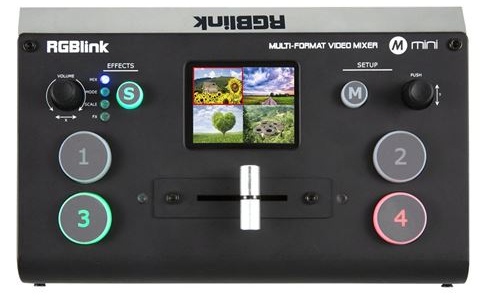
A lot
Actually way more than you might expect, or even dream off.
Lets star t with the inputs.
You can feed the RGB mini 4 sources.
This can be cameras, desktops, consoles, mediaplayer etc. it really doesn’t matter. The cool thing about the mini is that it scales all the inputs to the output (which you can set in the menu) so that means I can now connect my iPad (totally different resolution), my laptop and of course my cameras all to the same device without thinking about it and the mini will output what the other side wants, for most this will 1920×1080/60.
But there is more…. oh so much more.
If that isn’t enough, you also get a small LCD screen on the mini showing all 4 sources live without any delay, one might say that the display is too small but when you work with a live streams it’s large enough, you don’t have to watch the cameras, just know which one to switch too, and this screen gives more than enough room to judge this easily and fast. And if you really want to hook up an external screen… no problem there is also an HDMI out which can carry the “live” stream signal or the “PGM” in other words you see the 4 inputs, in my opinion, unless you work in a fixed setup hooking up an external screen is pure luxe but absolutely not necessary, compared to my other setup where it’s a must (because otherwise you can’t see the sources).
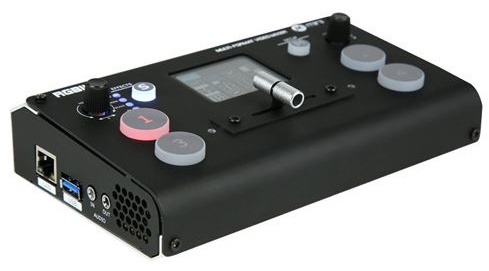
Let take a look at the side.
Here you can see the USB output, via this connection the Mini is hooked up to your PC/Mac and the OS will recognize the Mini as a “webcam device/External camera”. You also see the network connector which makes it possible to hook the mini up to the network and control the mini via the OS or even via your iOS and soon Android device (I’m running a 100% working beta), the tablet/phone can be on wifi of course.
On the side you also see two small jack inputs.
One is for headphones and one is for line in.
In our situation this means that we input my audio straight into the Mini and use a headphone to check.
You do have to realize that this is a LINE in, so you need a powered microphone or a mic pre-amp. In my case we use a small mixer in the studio and in our home setup I use the console from the music recording studio setup, but in essence audio in can be a simple as you want as long as it’s a line level.
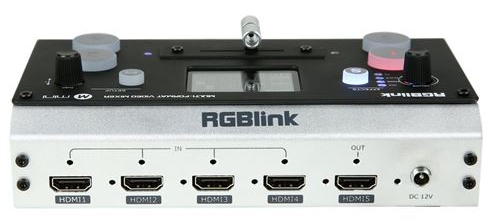
On the back are the four HDMI inputs, one HDMI out and the powerconnector.
Settings and setting things up
This is where a product rises or falls down HARD.
On paper it’s always easy, but now put someone in a live stream situation where you have to focus on the audience, what you’re doing and controlling the live stream plus chats… you don’t want to think about stuff, you want to click and switch and that’s it.
Well it’s that easy.
As long as you switch between cameras there is no problem at all.
In the menu you can select which effect you want and after that you click the number to make it “hot” and move the slider from one side to the other to make it “live” do it slow and the images really blend nicely together, do it fast and it’s almost like a cut, this is a really nice trick you can use for live concerts etc. to follow the mood while switching cameras, just one piece of advise, don’t go crazy with the effects, a zoom effect is cool once or twice but every few seconds….. I always go for the nice cross dissolve or fades, which makes it a lot easier for the viewer.
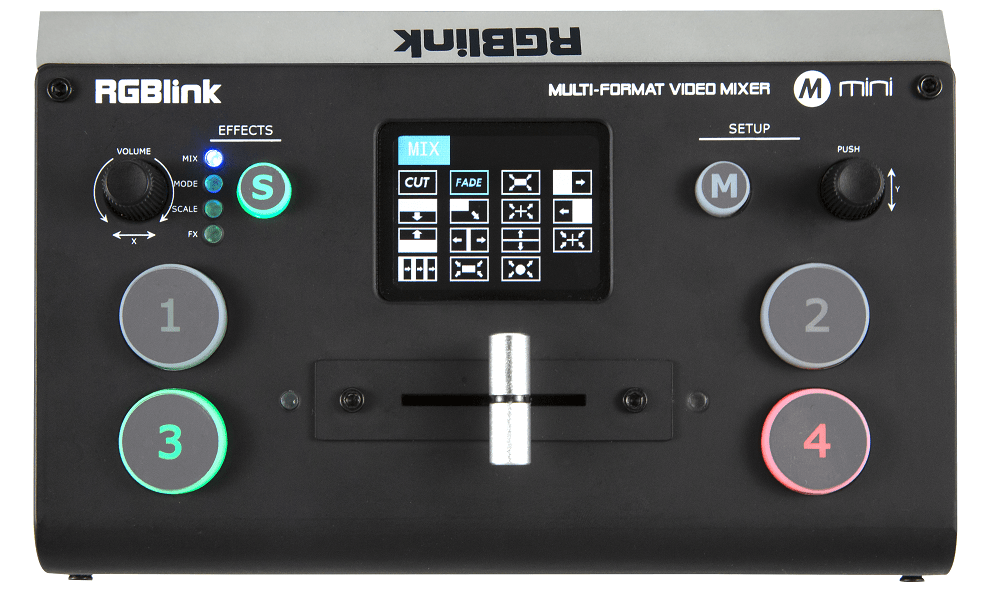
When you want picture in picture the story changes
In all honesty this is why the review took so long.
When I got the device in, everything was absolutely great, as long as you kept it simple. When you wanted to go to the picture in picture it was a disaster, over complicated, no visual reference and a lot of clicks and wipes to find out you did something wrong, or forgot to select something before. It wasn’t good.
Now in most cases this would mean, end of story. Send the device back.
We also experienced a problem with controlling the Mini via Wifi and/or desktop and you might think “Ok, why didn’t send it back?”
The first thing we always do is contact the one that send us the device, maybe I missed something.
They got us into contact directly with RGBLink, now I have to be honest in most cases this doesn’t mean a lot, mostly they listen and say “yeah… yeah….” and that’s about it, years later it will still not change, but this went a slightly different direction.
After telling them the problems I experienced with Picture in Picture and also explaining to them that it works when I’m sitting down relaxed but it was too complicated when I was under stress I also gave some options about reprogramming some keys that would make the process a lot faster and easier, just venting ideas not ever thinking they would actually do it. However much to my surprise a few hours later I already got confirmation they were working on it.
Now you also have to be realistic, this is not a 999.00 device.
For what it does and how it’s build it’s an absolute miracle how they did it so you expect to make some sacrifices right?
One of them being that I select picture in picture I just wish my image would be a bit smaller and the main screen also a bit smaller so they don’t overlap too much, but that’s probably too much to ask.. right?…… well, according to the last information it will be added in the future (I asked this 3 days ago).
Oh and also our network issue, solved within one firmware upgrade.
DISCLAIMER… this thing was brand new on the market when we got it, with a firmware below 1.
So small bugs are pretty usual with this, the way they are solved is something else.
For me this all adds up to my joy I experience from a device, but most off all also about the way I can use it instead of fight it.
The way it operates
what I love about a device like this is that it does everything.
I advised one to a friend of mine that now does live concert streaming with just one device instead of renting a whole setup every time costing him a small fortune, and the quality is great, but most of all I could help them over the phone hooking everything up, something I would normally never be able to.
The way the Mini behaves is like this.
You hook everything up.
Set the output format (1920×1080/60 for example)
Connect the audio to the Mini (or use audio on the desktop)
Connect the USB to the computer
Open up ANY software that supports a webcam (zoom, twitch, YouTube, Vimeo, Facebook etc) and instead of your webcam select the mini…. and voila that’s it you’re all setup.
You might wonder “really”…
Yep really.
That’s the cool thing about the mini, it handles all the difficult stuff like converting HDMI to USB, Converting 720P to 1080P or RGB to YUV or 25fps to 30fps you don’t have to set it up, you don’t even have to think about it. Just connect it, and start switching.
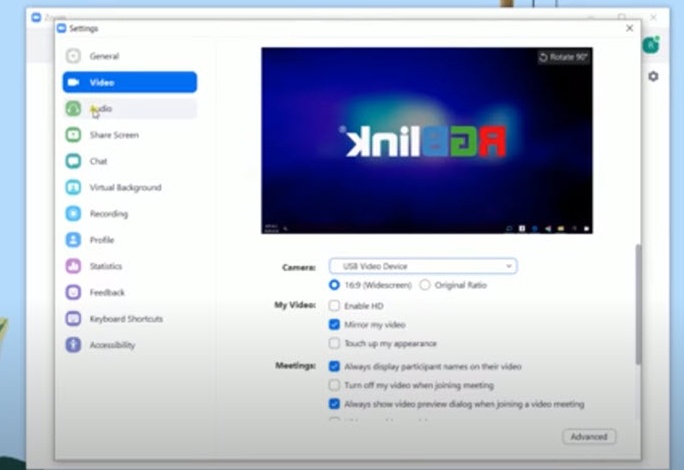
Some things that could be better
I won’t talk about software, because at the moment when they add the picture in picture resizing I don’t have anything I could think off to add. (yes it’s really that good).
The thing that I find a bit weird is the layout.
In the center you have the T-bar and on both sides you find the buttons for the sources.
Seeing you move the T-bar for the switching of sources it feels a bit weird to select a source on the left and slide the T-bar to the right. I would prefer to see 4 mini displays with buttons under the screens, or a square screen with buttons next to it (screen in the center) and one bar on the bottom of the device that moves from left to right. This way you don’t feel like you move the T-bar towards a source. In all honesty I’m now 100% used to it, but it still feels a bit awkward.
And finally I would have loved for them to add a simple On/Off switch. I don’t really get it why more and more devices lack this. Now you have to pull the powersupply out and when you use several devices a mistake is made easily when someone cleans your desk 🙂 and seeing you can really damage a device with the wrong power I would love to see a switch.
Conclusion
“Frank, I don’t live stream, thanks for the review but….”
Remember what I said at the beginning?
“Even when you don’t do any streaming, keep reading to the end”
Over the past year we have had a lot of virtual meetings and calls, and plenty of times I got the remark “man you look great, what kind of webcam and audio is that?”, people just don’t expect a clear hi-def image and audio from zoom or facetime I guess. The other huge benefit is that when you want to hang out with friends or family you can use the family handycam, set it up all zoomed out and enjoy the whole room, and …. how about playing a game, feed the console or another camera aimed at the playing board (when you love boardgames) and use Picture in Picture for some old fashioned together time (but online now).
The possibilities for live streamers are known.
But the possibilities that these VERY affordable devices can give to normal consumers is often not realized yet, but I strongly believe it can really bring us much closer to each other by using different cameras (which we often already have) and more sources and PIP options to get away from that terrible webcam image you get when you facetime with someone, this way it’s much more like being there and you don’t have to constantly say “I’m seeing the ceiling…. please lower the camera”
But also think about businesses.
Drop the Mini in your bag, set it up at the office and place one camera on yourself and connect the powerpoint to another source input (or share screen) and stream live, drop in the bag and take it back home to use there.
But also when there is no power.
The mini can easily be connected to a good powerbank (for example an Omnicharge) and will run for as long as your laptop probably. We will without a doubt be using this solution when traveling having a device like the Mini with everything on board is just a breakthrough. And as mentioned before there are alternatives, but nothing with a display that I know off below 700.00 euro and with 349.00 the mini… well there is no competition.
If you read all the way to the end I’m 100% sure you are interested by now.
If you have any questions feel free to ask.
For me the Mini is a HIGHLY recommended device and especially the communication with RGBLink is more than great.
If you want to use PZT cameras there is also Mini+
If you also want one of the these Mini switchers, follow this link and you also support our work.
https://amzn.to/2LG24PF
If you wish to buy in Europe find here your local RGBLink Mini reseller and click on their online webshop.


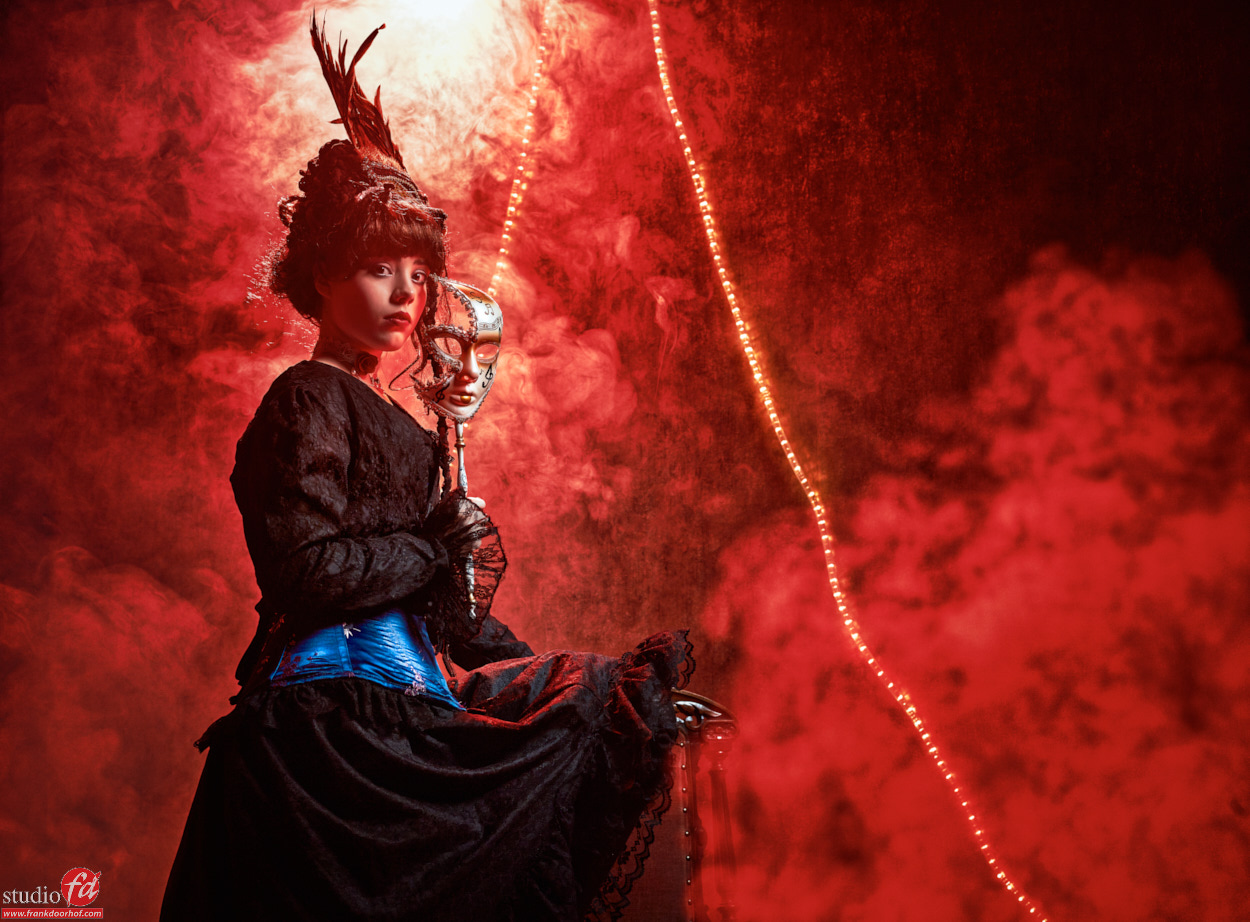

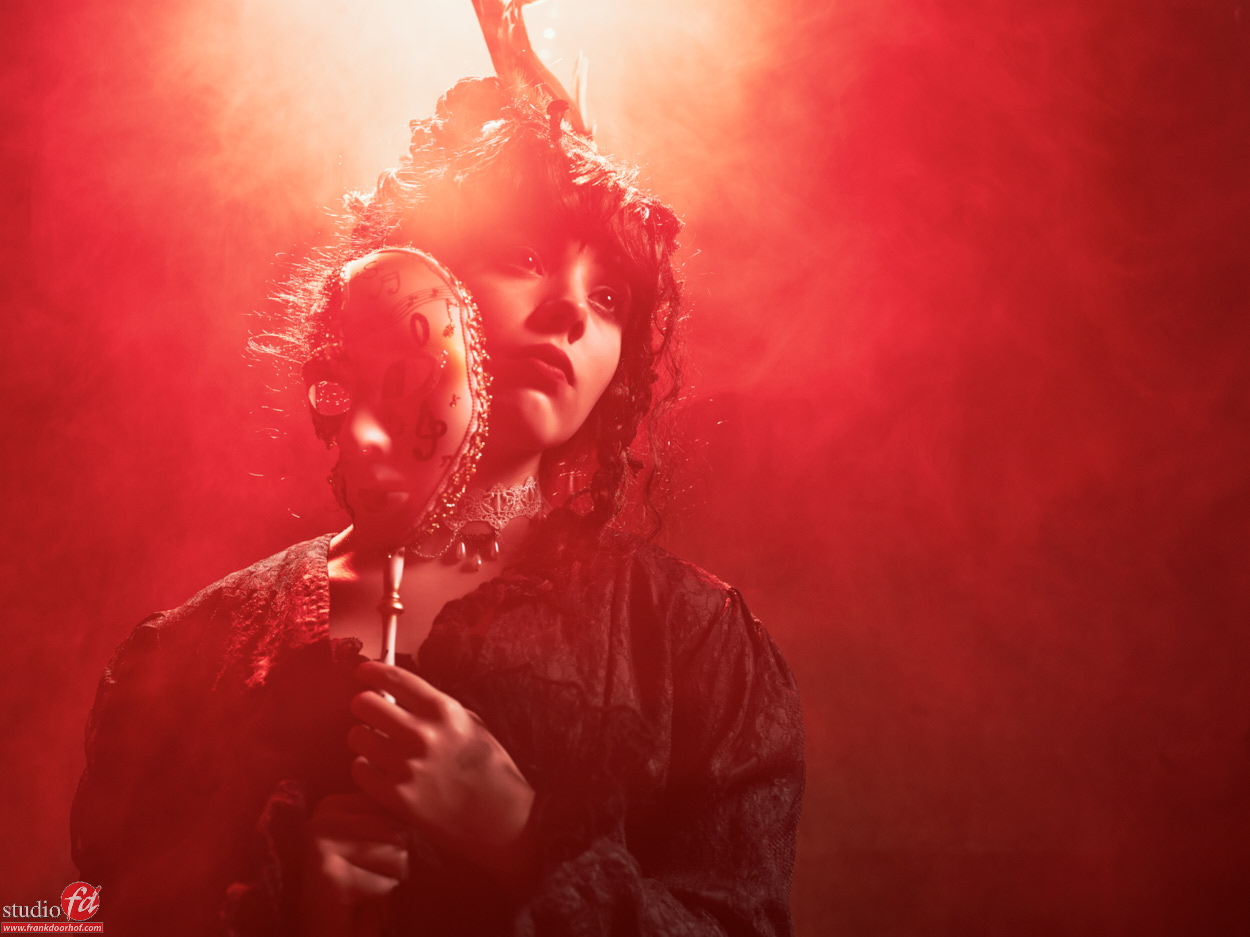
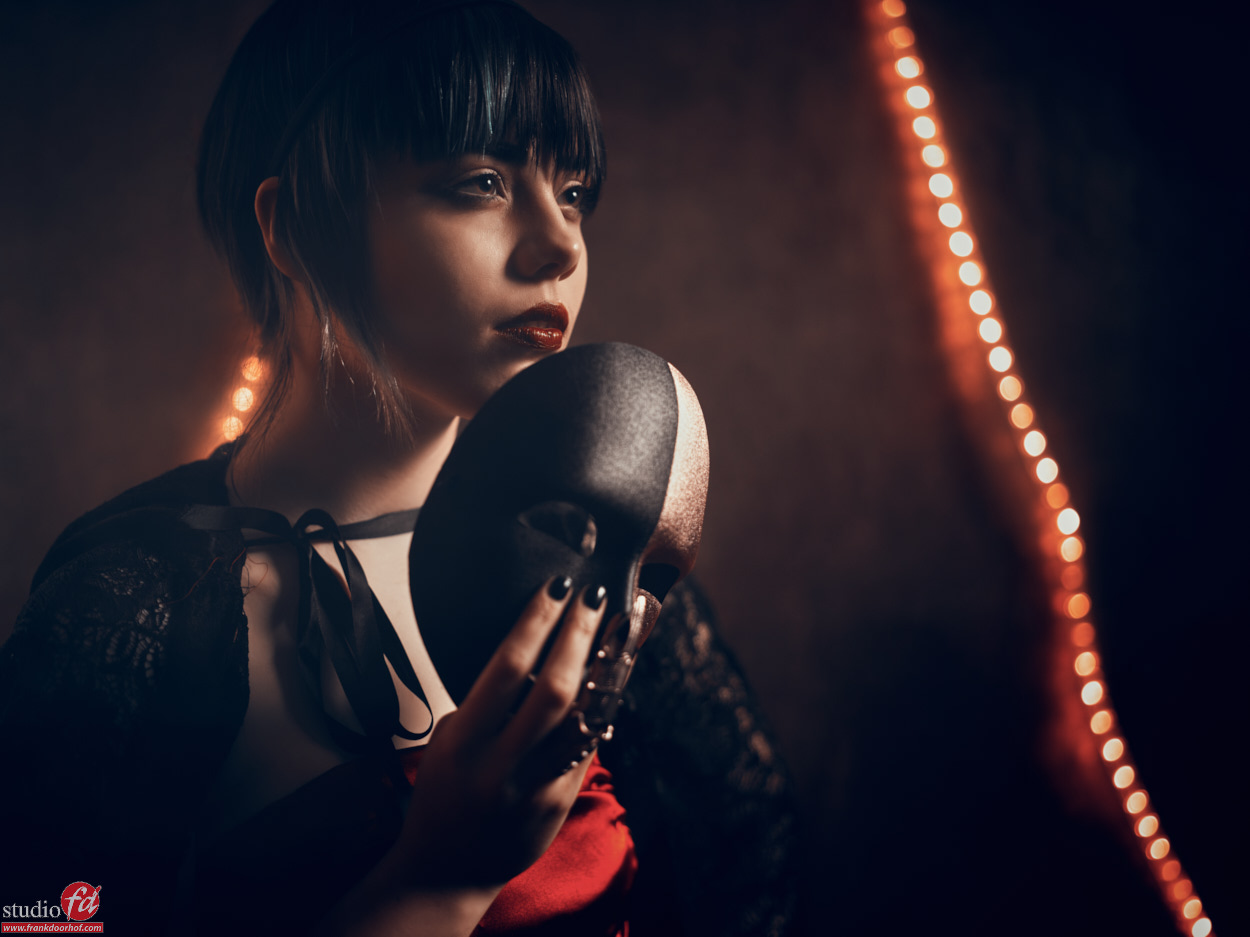
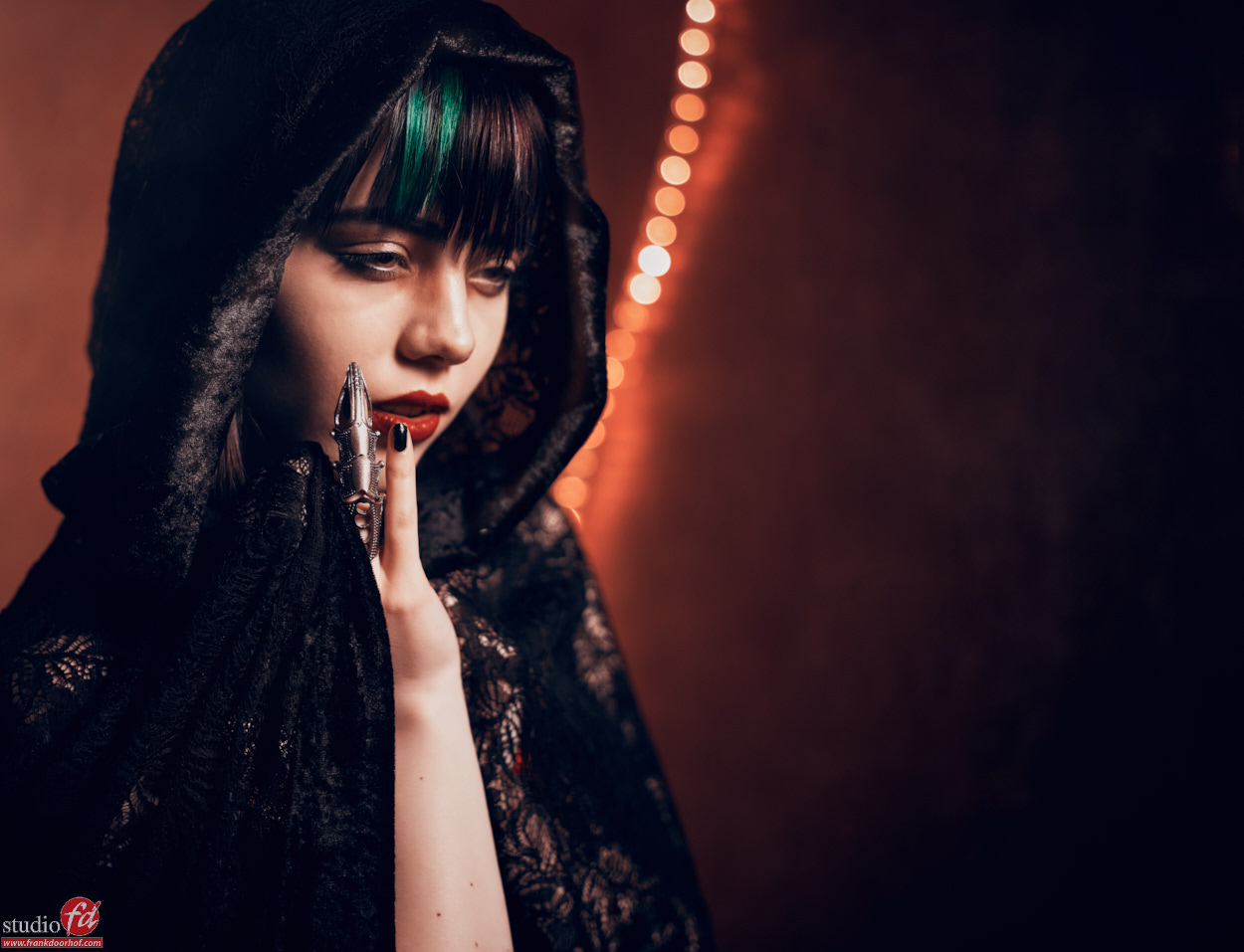

You must be logged in to post a comment.